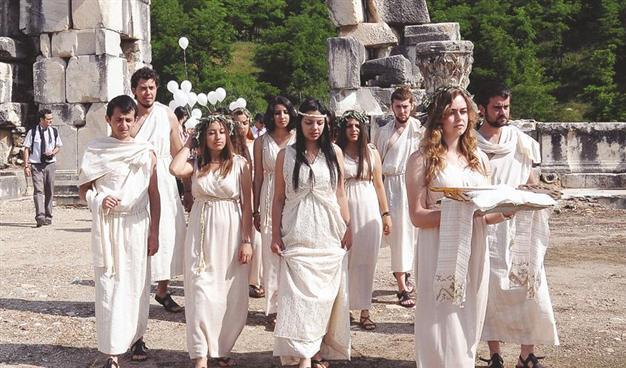History revived in ancient city
MUĞLA - Anatolia News Agency

The festival has hosted Pamukkale University students at archeological sites Stratonikeia. Students entered Stratonikeia from the North City door and Italian representatives of the project walked through the stone roads. AA photo
History is being resurrected with a new program of the Provincial Education Directorship. The project, which focuses on discovering history and culture under the title of “Those who do not know history cannot know the future,” is taking place in collaboration with the Comenius Regional partnership project. The project has organized a festival named “Archetory Festival.”The festival has hosted Pamukkale University students at archeological sites such as Muğla’s Stratonikeia and Lagina Ancient cities. Students of the archeology department have walked along the sacred road, which is 3,000 years old and nine kilometers long. The students revived an ancient tradition in doing so.
Students entered Stratonikeia from the North City door and Italian representatives of the project walked through the stone roads of the city. All of them gathered at the amphitheater.
The students gave the keys to the city to Yatağan Mayor Hasan Haşmet Işık.
Işık also spoke at the opening of the festival and said: “Yatağan has many cultural values and they need to be presented to the world.” Noting that the friendships that were made years ago were now being revived again, he said they were very happy about it.
The manager of the provincial education directorship Zekriya Çınar said the project’s events began in 2011 and developed a lot over two years. The project’s aim is to support the sharing of information on culture between the two countries.
Noting that the Stratonikeia site had been determined as the working area of the project, Çınar said: “This is a good way to make this ancient city more popular in the international and the national arena.”
With this project the city and the area will also be presented, and the students will learn the history, he added.
Sacred road
It is possible to find traces of culture and civilization dating back over 3,000 years, added Bilal Söğüt, the excavation president.
The world’s largest marble city, the ancient city of Stratonikeia in the Aegean province of Muğla’s Yatağan district, is expected to be included in the temporary list of UNESCO world heritage sites.
The head of excavations at the ancient city and Pamukkale University Professor Bilal Söğüt said Stratonikeia, one of the most important cities in the Caria region, was a settlement of Carians and Lelegs, both local Anatolian populations, and also survived as a settlement during the Hellenistic, Byzantine, Ottoman and Republican periods.
Söğüt said they unearthed significant artifacts during the archaeological excavations every year. “This is a living archaeological city. It is unique. There is no other city where structures have survived as a whole since the ancient period. This is why the city should be listed as a cultural heritage site. We will finish the work this year and deliver the necessary forms to the General Directorate of Museums,” he said.
The students and representatives walked between Lagine and Stratonikeia. One of the Italian partners of the project, Sophie Canteneur, said they had participated in the project with 11 people.
















